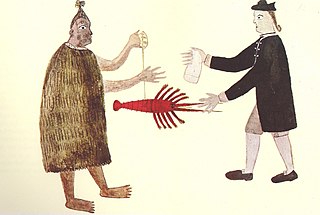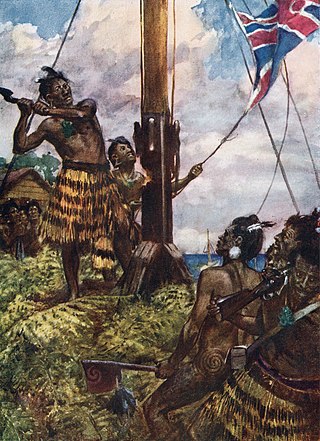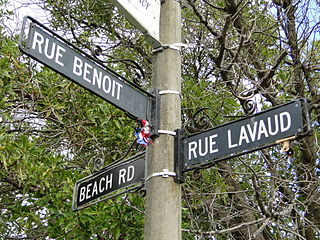
The Treaty of Waitangi, sometimes referred to as Te Tiriti, is a document of central importance to the history of New Zealand, its constitution, and its national mythos. It has played a major role in the treatment of the Māori people in New Zealand by successive governments and the wider population, something that has been especially prominent from the late 20th century. The treaty document is an agreement, not a treaty as recognised in international law, and has no independent legal status, being legally effective only to the extent it is recognised in various statutes. It was first signed on 6 February 1840 by Captain William Hobson as consul for the British Crown and by Māori chiefs from the North Island of New Zealand. The treaty's quasi-legal status satisfies the demands of biculturalism in contemporary New Zealand society. In general terms, it is interpreted today as having established a partnership between equals in a way the Crown probably did not intend it to in 1840. Specifically, the treaty is seen, first, as entitling Māori to enjoyment of land and of natural resources and, if that right were ever breached, to restitution. Second, the treaty's quasi-legal status has clouded the question of whether Māori had ceded sovereignty to the Crown in 1840, and if so, whether such sovereignty remains intact.

Captain William Hobson was an Anglo-Irish officer in the British Royal Navy, who served as the first Governor of New Zealand. He was a co-author of the Treaty of Waitangi.

The Flagstaff War, also known as Heke's War, Hōne Heke's Rebellion and the Northern War, was fought between 11 March 1845 and 11 January 1846 in and around the Bay of Islands, New Zealand. The conflict is best remembered for the actions of Hōne Heke who challenged the authority of the British by cutting down the flagstaff on Flagstaff Hill at Kororāreka. The flagstaff had been a gift from Hōne Heke to James Busby, the first British Resident. The Northern War involved many major actions, including the Battle of Kororāreka on 11 March 1845, the Battle of Puketutu on 8 May 1845, the Battle of Ōhaeawai on 23 June 1845 and the siege of Ruapekapeka Pā from 27 December 1845 to 11 January 1846.

Russell, also known by the Māori name Kororāreka, is a town in the Bay of Islands, in New Zealand's far north. It was the first permanent European settlement and seaport in New Zealand.

Akaroa is a small town on Banks Peninsula in the Canterbury Region of the South Island of New Zealand, situated within a harbour of the same name. The name Akaroa is Kāi Tahu Māori for "Long Harbour", which would be spelled Whangaroa in standard Māori. The area was also named Port Louis-Philippe by French settlers after the reigning French king Louis Philippe I.

Ngāpuhi is a Māori iwi associated with the Northland regions of New Zealand centred in the Hokianga, the Bay of Islands, and Whangārei.
Captain William Cornwallis Symonds was a British Army officer who was prominent in the early colonisation of New Zealand.
James Reddy Clendon was an early European settler in New Zealand, the first United States Consul to New Zealand, and he was a witness to the Declaration of the Independence of New Zealand (1835) and the Treaty of Waitangi (1840).

Henry Williams was the leader of the Church Missionary Society (CMS) mission in New Zealand in the first half of the 19th century.
The following lists events that happened during 1839 in New Zealand.
The following lists events that happened during 1834 in New Zealand.
Foveaux Strait is the centre of attention for sealing ships. Sealing gangs are dropped along the coast from southern Fiordland to Otago Harbour and on Stewart Island / Rakiura. The Bay of Islands is sometimes on the journey to or from Port Jackson. The Chatham Islands are also visited. A few whalers also operate around New Zealand; some also collect timber from Bay of Islands.
MokaKainga-mataa [Te Kaingamataa/Te Kaingamata/Te Kainga-mata/Te Kainga-mataa] (1790s–1860s) was a Māori rangatira (chief) of the Ngā Puhi iwi from Northland in New Zealand. He was distinguished in war and an intelligent participant in the Treaty of Waitangi process.
Gilbert Mair was a sailor and a merchant trader who visited New Zealand for the first time when he was twenty, and lived there from 1824 till his death. He married Elizabeth Gilbert Puckey – who had the first piano brought to New Zealand in 1827. They had twelve children. Among them were "famous New Zealanders" like Captain Gilbert Mair and Major William Gilbert Mair. Mair is a direct-line ancestor of Māori politician and activist Ken Mair.

Wellington has been the capital of New Zealand since 1865. New Zealand's first capital city was Old Russell (Okiato) in 1840–41. Auckland was the second capital from 1841 until 1865, when Parliament was permanently moved to Wellington after an argument that persisted for a decade. As the members of parliament could not agree on the location of a more central capital, Wellington was decided on by three Australian commissioners.

The Nanto-Bordelaise Company — formally La Compagnie de Bordeaux et de Nantes pour la Colonisation de l’Île du Sud de la Nouvelle Zélande et ses Dépendances — was a French company inaugurated in 1839 by a group of merchants from the cities of Nantes and Bordeaux, with the purpose of founding a French colony in the South Island of New Zealand.

Edward Marsh Williams was a missionary, interpreter, and judge who played a significant role in the British colonisation of New Zealand. He was born in Hampstead, Middlesex, the eldest son of Archdeacon Henry Williams and Marianne Williams.
James Coates was a prominent pioneer settler of Auckland, New Zealand. He was also a senior official within the administration of the newly-established colony of New Zealand, following the proclamation of sovereignty by William Hobson and the signing of the Treaty of Waitangi in 1840.

Pōmare II, originally named Whiria, was a Māori rangatira (chief) of the Ngāpuhi iwi (tribe) in New Zealand and the leader of the Ngāti Manu hapū (subtribe) of the Ngāpuhi. He was the nephew of Pōmare I, his mother Haki being the elder sister of Pōmare I. When he succeeded his uncle as leader of the Ngāti Manu he took his uncle's names, Whētoi and Pōmare. He is referred to as Pōmare II, so as to distinguish him from his uncle.

Charles Frederick Baker was an English member of the Church Missionary Society (CMS) active as a missionary in New Zealand in the 19th century. He supervised the construction of the historic church at Russell and was involved in the Treaty of Waitangi proceedings, a collection consisting of his journals and papers was added to the UNESCO Memory of the World New Zealand register in 2018.











